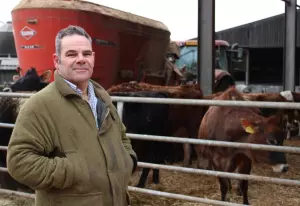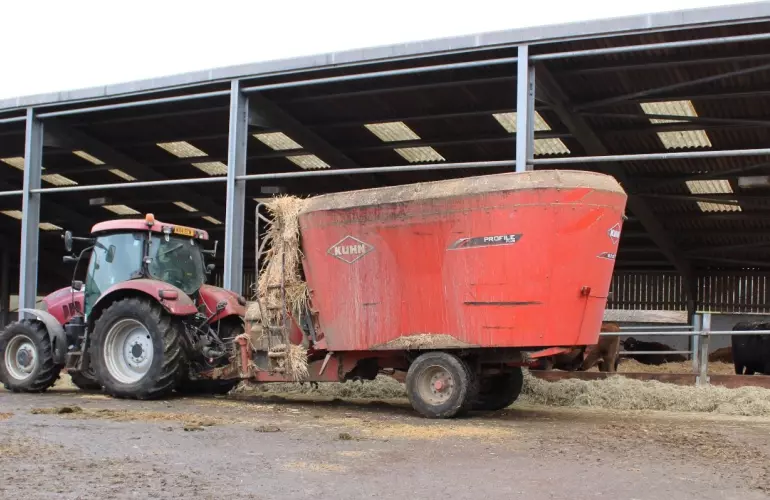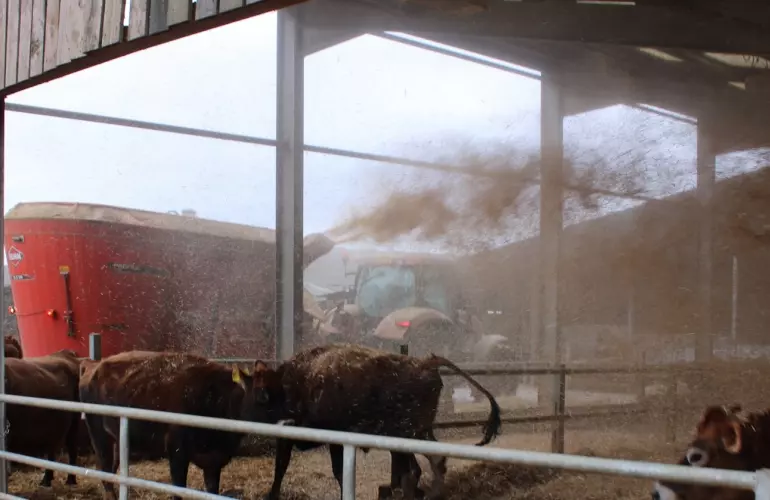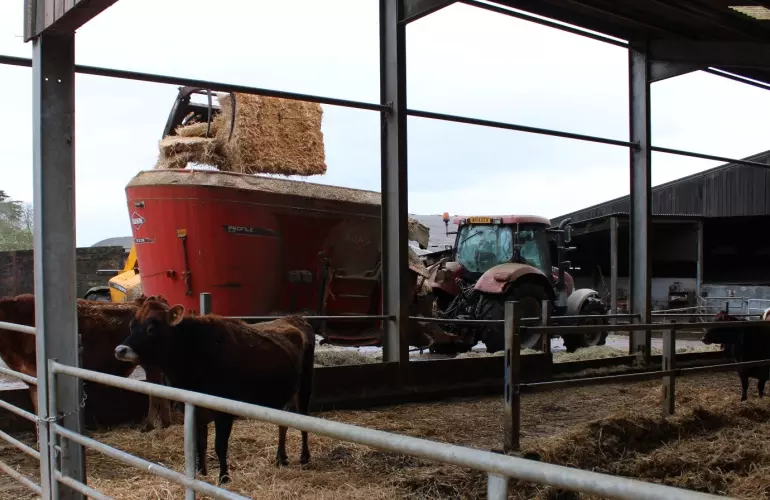Feeding and bedding 280 milkers has been made easier, quicker, and more accurate for farm manager Paul Redmore since he introduced a KUHN Profile Plus feeding and bedding machine to the Neston Park Estate near Corsham, Wiltshire.

The 850 hectare in hand farm is home to an organic Jersey herd and Mr Redmore has kept with tradition by using homegrown straw bedding and silage.
“We are feeding and bedding down morning and afternoon, whilst the cows are milked. The process needs to be flawless; we want to make the best environment for the cows to reduce any risk of mastitis and provide them with a calm atmosphere.”
He previously used a mixer wagon and a separate straw chopper which meant finding two tractors, twice a day, or swapping each machine on and off the same tractor. The Profile Plus 2 DS has two vertical augers, a straw-blowing turbine, and spout to feed out via a direct side door which gives him the flexibility to feed and bed in all of the farm’s sheds. Mr Redmore opted for the 18.2 model which offers an 18m3 capacity and has a neat turning circle of just 8 metres.

“We use up to 12, 6-string bales, per day. It takes two hours to milk, scrape, feed and bed down 280 cows. One person milks, whilst the other scrapes, feeds and beds. Having a combination machine to feed and bed is saving us between 30-45 minutes and the new machine is more accurate and faster at preparing the ration.”
The Profile Plus fulfils the twice-a-day bedding routine and is also helping to manage feed accuracy. Mr Redmore has the option of feeding at ground level but can also feed directly into troughs four foot high via the straw blower. He is keen to emphasise that consistency is the key to his routine, both for him and his team, but more importantly for cow welfare and milk production.
The polygonal shape of the front, rear and sides of the chamber ensures smooth fodder circulation. It also means the entire volume of the chamber is used during chopping and mixing which prevents fodder build-up. The double-pitch angle of each auger guarantees quick breakdown of feed, no matter how full the machine is.

“The accuracy and consistency of the mix stops cows sorting the feed. This is better for the cows because they love consistency, and it also translates into higher yields.”
He analyses silage every two months as he peels back the clamp. Working with a nutritionist to calculate the optimum total mixed ration (TMR), he is able to use the Profile Plus to accurately weigh each component.

“Testing silage and monitoring the TMR is helping to maintain cow health and productivity. The machine can deal with any grade of material and the chopping knives provide a consistent mix. This is also saving feed which is lowering our costs.”
The internal weighing function of the Profile Plus also enables Mr Redmore to make the most efficient use of straw for bedding.
“The weigh scale means I can monitor and control straw use for the various sheds whilst monitoring how much is in the tub to minimise journeys. We can even split bales to bed the smaller sheds. We can fit two and a half 6-string bales in the tub and having this capacity has reduced the time and fuel needed to bed the sheds each day.”
The chopper in the Profile Plus adds an extra level of precision and makes loading and preparing the straw easier and more accurate. The two augers are driven on the same driveline and mix the product in a figure-of-eight pattern, which increases product flow in the chamber, with no blockages and no additional power requirement.
“The straw chopper reduces the amount of straw we use by about 30%. This is because we are avoiding waste through lumps going through into the sheds and creating an even layer of shredded straw. The blower is also very accurate and versatile enabling us to bed wide areas and even cubicles.”

The Profile Plus features an optional KUHN’s Cleanstraw function which reduces dust in livestock buildings by applying a fine mist of water to straw as it is distributed. It comprises a 64-litre water tank and three misting nozzles mounted at the exit of the straw-blowing chute. The nozzles are fed by a pump which provides water at a flow rate to apply one litre of water per 100 kilos of straw, without slowing the machine’s normal performance.
Applying a mist of water at this rate, and in this way, eliminates excessive levels of airborne dust by reducing the amount of time that these particles remain suspended in the air. Trials have shown that the air in a typical livestock building will be dust-free within 30 seconds after straw-blowing with the Cleanstraw system has ceased, compared to several minutes without the Cleanstraw facility.
“Adding a fine mist of water as straw exits the spreading chute means very little water is required. The low water usage also means the straw still has high absorbency which makes it more hygienic.”
The Profile Plus was 30% less to buy than having two separate machines. It also requires less operator time and fuel to carry out the daily feeding and bedding work. To reduce power consumption, the Profile Plus utilises asymmetric knives which have a self-cleaning effect and progressive-cutting knife edge for constant torque transfer. The continuous auger helix moves the fodder from the bottom to the top of the tub for even mixing with no forced movements which reduces fuel consumption during the mixing process.

“It also reduces maintenance because we only have one machine to maintain, and it only requires basic greasing once a week. We were surprised with the low power output. It runs at a PTO speed of 540 which is saving fuel. It is the best of both worlds and a valuable machine for the farm,” he concludes.
